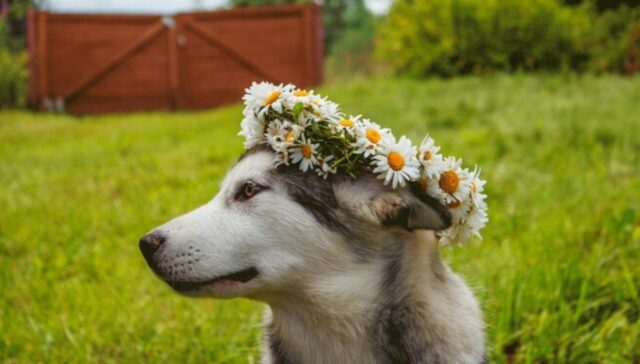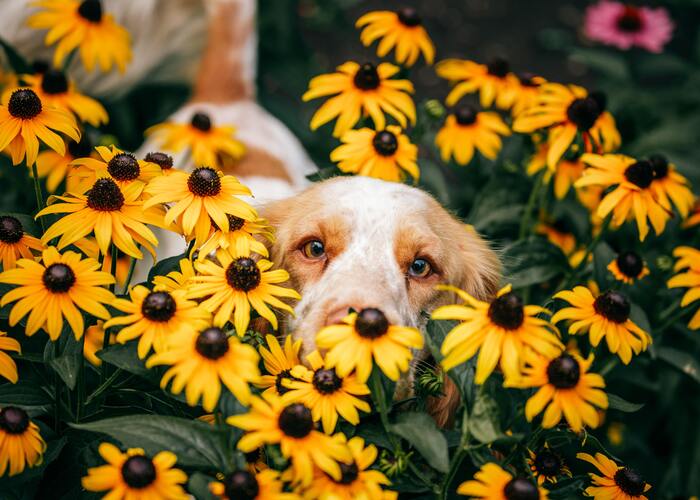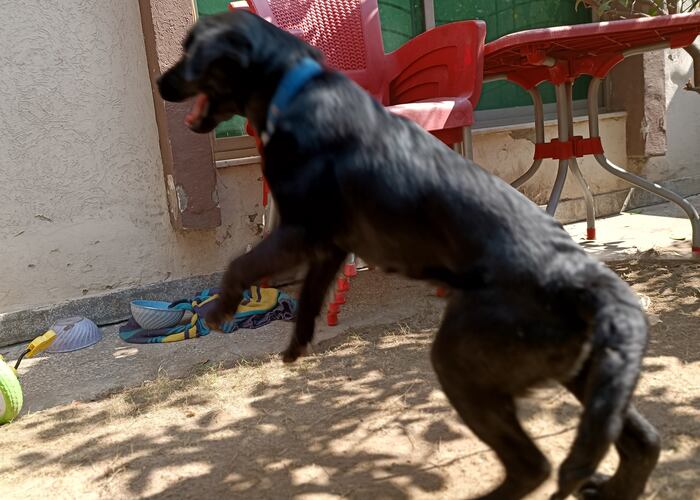
Table of Contents
- Dog Springtime Checklist
- 1. Spay or neuter your pet
- 2. Get them vaccinated
- 3. Time for some exercise!
- 4. Microchip them to stay connected
- 5. Get a first-aid kit for emergencies
- 6. Well-groomed pets look and feel better
- 7. The shedding season is here
- 8. Springtime fashion
- 9. Time for some clean bedding and toys
- 10. New season, new puppy essentials
- Fun Activities To Try With Your Pet Dog During Springtime
- The Dangers of Springtime for Dogs
- Dog Springtime Checklist: Final Word
Going from winter to spring can be a magical experience, especially with our furry friends.
Witnessing them explore the renewed colors and vitality of the blooming flowers and plants truly lights our faces.
But at the same time, it also brings a set of things we need to do to ensure everything goes alright, especially for our furry friends.
This is because every season has its perks and challenges. While your dog may adore outdoor activities and walks, it will also undergo biological and social changes.
As a responsible pet parent, you must address them so your canine companion can stay healthy and active.
Here, we have compiled an organized checklist to simplify the task. Tick off the boxes as you go (or skip if it's not applicable).
Dog Springtime Checklist
It's springtime, and it's the best time to have some fun with your pooch!
But before you do that, you might want to check this dog springtime checklist first:
1. Spay or neuter your pet
Springtime is a popular month for reproduction in dogs. While puppies are born all year round, female dogs give birth to larger litters during this time.
Neutering or spaying your pet may assist in reducing their aggression and reduce their likelihood of escaping your home to find a potential partner.
2. Get them vaccinated
Many pet parents love the spring owing to the ease of outdoor activities.
You will likely go on adventurous hikes or have a pleasant pet date with other dog enthusiasts.
This may increase your dog’s chances of getting a virus or disease from the dangerous pathogens that plague the outside world.
So, the best way to minimize this risk is to stay updated on your dog’s vaccinations and get them the appropriate dose as required.

3. Time for some exercise!
The cold winter may have put you and your pup in a cozy routine of snuggling and snacking indoors.
But this can create an inactive and unhealthy environment for you and your pet. The relatively warm and bearable sun during spring is ideal for exercise.
It doesn’t have to be too much. We recommend starting off slow and taking your time adjusting to the changes.
You and your pooch can go for a walk in the backyard or around the block for as little as 15 to 30 minutes. You got this!
4. Microchip them to stay connected
Spending time outside may increase the likelihood of your pet getting lost or stolen. It can be a hassle as you try to search for them.
Sometimes, even calling the concerned authorities may be futile.
An easy way to avoid such an emotionally draining situation is to get your dog microchipped.
Once that is done, any individual who finds your canine companion can contact you through the number given on the unique identification number.
This means you can find your pet regardless of how far they wander.
5. Get a first-aid kit for emergencies
Picture this: you went hiking with your pet, but a sharp-edged branch on the ground scraped their leg.
Your pet might limp a little, and a little blood might need washing.
Having a first-aid kit can help you address the injury immediately to avoid potential infections.
This is especially essential during springtime when there’s an increased chance of sickness due to more time spent outside and possibly far from home.
6. Well-groomed pets look and feel better
Bathing and trimming a dog’s coat may not be the wisest decision during winter because of the threat of catching a cold. But this changes during the spring.
Long-haired dogs such as the Afghan Hound and Bearded Collie may feel better once their magnificent coat is cleaner and shorter to survive the upcoming heat.
7. The shedding season is here
The advent of spring also means the start of the shedding season. Your pet may start losing a lot of hair due to the temperature change.
It is nature’s way of making space for the lighter undercoat to survive the heat.
While most dogs require weekly grooming, it may have to be switched to a daily schedule.
This will help remove loose hair and minimize the chances of dog hair (and possibly dander) flying everywhere.
8. Springtime fashion
If you’re into fashion and photography, you’ll love dressing your adorable dog in a cute dress or suit and taking pictures.
It can be a small pet picnic date where you have a bonding session with your canine companion in the sun, playing a game of fetch.
You can also set a theme and ask other pet parents to show up at your home. There’s no better time to do it than spring, after all.
9. Time for some clean bedding and toys
While you’re ditching out the warm clothes for some spring fashion, remember your furry friend needs a change, too.
They may not have clothes to change into, but they have beddings and toys that need washing.
You can also go one step ahead and hand-wash the leashes and collars. Your pet would love its accessories to feel clean and fresh.
10. New season, new puppy essentials
A new season means a new wardrobe. Don’t forget to get some new toys, treats, fashionable dog collars, and tag accessories for your pet while you’re out shopping.
You don’t have to throw everything away in exchange for new ones.
But if something is worn out and needs changing, now would be the perfect time to do it.

Fun Activities To Try With Your Pet Dog During Springtime
Spring is the season of love and rebirth. It’s the ideal time to bond with your pet after months of staying indoors.
While the icy temperatures may have limited you indoors, now is the perfect time to explore the wilderness with your canine companion.
Here, we have compiled a list of fun activities to enjoy with your pet. Remember to start slow and have fun while you’re at it!
1. Go hiking
Dogs are innately curious animals that love feeling mentally and physically stimulated. They need it for optimum health.
Hiking is the perfect sport that checks both boxes. The neutral temperature during spring makes it the ideal time for hiking.
You will neither sweat profusely nor freeze in the icy breeze. The vibrant flowers along the tracks will guide you through!
2. Enjoy camping outdoors
Another outdoor activity you can enjoy with your pet is camping. Pack your suitcase and embark on a dazzling, starry night with your canine companion.
We recommend reading all pet-related information on the camping site you are headed to avoid any problems.
You can also bring along other pet parents or dog enthusiasts to share your joy. The more, the merrier!
3. Play fetch
You don’t have to go far to have fun with your pet. Although it would be an excellent idea to do so, it may not be feasible for everyone.
You can still find happiness in simple things like playing fetch with your active and friendly friend.
All you need to do is throw an object and reward your pet with their favorite treats. Repeat the process until your adorable dog gets the hang of it.
4. Organize a dog-friendly date
Are you romantically interested in another pet parent, or do you have friends who are also fellow pet parents?
If yes, then what better way to enjoy your mutual interests other than spending time with your favorite animal?
Pets are like family and can be an effective way to get to know someone.
You can plan a picnic or walk as you ask each other questions, with your dog walking with you for emotional support.
5. Plan a getaway
Life can be monotonous and dull sometimes. But it doesn’t have to stay that way.
Planning a getaway can help you escape your routine slump and do something spontaneous.
Fortunately, there are many dog-friendly vacation destinations in the US to enjoy with your dog.
We recommend reviewing the rules and regulations to avoid confusion or misunderstandings.
This will allow you to make the best of your trip and have the time of your life with your furry friend.

The Dangers of Springtime for Dogs
Dogs explore the world through their sense of smell and taste. They’re innately wired to sniff new objects they come across or lick them to judge how they feel.
This may be a problem when you’re outdoors and the entire expanse is filled with potential infections and toxins.
Understanding these dangers can help you keep a keen eye on your pet.
There are also various vaccinations you can give your pet to increase their immunity and fight against pathogens.
In this part of the blog, we’ll address everything dog owners need to be cautious of during springtime.
1. Parasites, Pests, and Animals
Springtime brings excellent flowers and greenery, but it also brings the threat of various parasites and pests. These include ticks, fleas, heartworms, and snakes.
All these dangers are at their highest when the winter months end, and they start invading safe spaces again.
So, preventative measures and medication are a must during this time.
We recommend limiting your pet’s contact with the outside world and the various stray animals that lurk within it.
Using an effective mosquito repellent to shield them against insect-related diseases would be best.
Brushing your pet’s hair daily can also assist in looking out for signs of fleas and ticks. This will help minimize the risk of contracting infections or other lethal diseases.
2. Hazardous Flowers and Fertilizer
Did you know some flowers and plants are harmful to dogs? Yes, you heard that right!
While these blooming blossoms may bring joy to your face, they might not do the same for your pet.
Noteworthy examples include hyacinths, daffodils, tulips, certain types of lilies, etc.
The fertilizer applied on various greenery for optimum growth may also trigger medical concerns in your pet.
Your pet may exhibit specific symptoms if they sniff or ingest them. These include excessive scratching, licking, rubbing, and shaking.
If required, we recommend taking them to your local veteran for a proper diagnosis and treatment.
3. Skin Allergies
Seasonal allergies are common during springtime.
These are mainly caused by pollen from the greenery that envelops everything during this time. Other causes include dust and mold.
Your dog will exhibit symptoms such as itchy and irritated skin from excessive scratching.
An effective low-cost remedy to soothe and nourish your pet during this time includes an oatmeal bath at home.
However, it is generally advisable to contact a veterinary professional if the condition is too severe to treat at home.
4. Other Dogs
Springtime is a fantastic opportunity to interact and socialize with other pet owners. You may meet one while walking or playing fetch in a park.
As great as it may feel, you must also be mindful of your dog’s interaction with other dogs.
Not every dog you encounter will be healthy or adequately immunized.
While you may vaccinate your pet, exposing them to unnecessary pathogens or lethal diseases still puts your dog at risk of sickness.
We recommend limiting socialization to animals you’re sure are safe to hang out with to minimize potential danger.
5. Escape
Dogs love adventures and exploring the world beyond their home.
The various visual and auditory stimulations beyond the fence may invite them to leave their home.
This is especially true for dogs that have not been neutered or spayed.
They may escape on their journey to find a potential partner to mate with.
So, we recommend that you spay or neuter your pet to relieve physical and psychological distress.
But, if that is not the course of action you want, you must keep an eye on your lovely pet to ensure their safety.
Dog Springtime Checklist: Final Word
Spring is a beautiful time to explore the outdoors with your canine friend.
The days are bigger and brighter, and the blooming flowers wither the gloomy winter aura away.
You can go hiking, camping, play fetch, or sit calmly on your lawn under the warm sun.
But as fun as it may be, there are concerns and responsibilities you have to address as a pet parent.
We hope this article gives you a practical insight into everything you need to do.
It may seem like a lot of work initially, but it’s pretty simple once you start.
These seasonal transitions may be complex, but we encourage you to take it one paw at a time!












